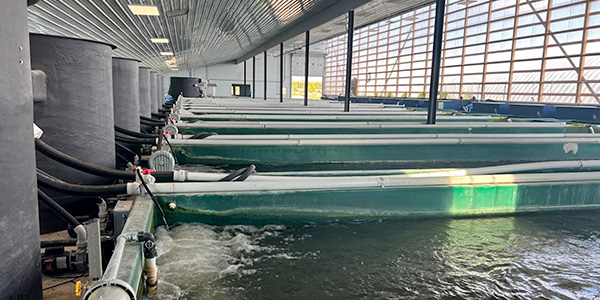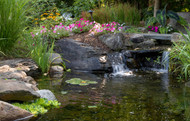Koi Pond Plants That Enhance Water Quality
Posted by Kloubec Koi Farm on 19th Aug 2025
Several aquatic plants excel at enhancing koi pond water quality while creating vibrant ecosystems. Oxygenating plants like hornwort and waterweed produce crucial oxygen and help control algae growth. Floating plants, including water hyacinth and water lettuce, absorb excess nutrients and provide essential shade. Marginal plants such as water iris offer natural filtration through their robust root systems while stabilizing pond edges. Together, these plants form a natural filtration system that maintains clear water, supports beneficial bacteria, and creates a healthy environment for koi. Understanding the right combination of these aquatic plants opens the door to maintaining a pristine pond ecosystem.
Benefits of Aquatic Plants
Sustainability in koi pond maintenance heavily depends on the presence of aquatic plants. These exceptional organisms serve multiple essential functions, from improving water quality to creating a thriving ecosystem. When selecting pollinator friendly plants, pond owners can simultaneously support local wildlife while enhancing their koi habitat.
Submerged plant benefits are particularly significant, as species like hornwort actively oxygenate the water through photosynthesis, supporting koi health and reducing algae growth. However, careful attention must be paid to avoid invasive aquatic species that can overwhelm the pond ecosystem. Proper plant care techniques, including regular pruning and monitoring seasonal plant growth patterns, guarantee that beneficial plants thrive without becoming problematic.
The combination of floating plants like water hyacinth and marginal vegetation creates natural filtration systems that reduce the need for chemical treatments. These plants work tirelessly to absorb excess nutrients, provide shade for koi, and offer protection from predators. By understanding and managing the seasonal cycles of aquatic plants, pond owners can maintain crystal-clear water while creating a beautiful, self-sustaining environment that their koi will thrive in.
Essential Oxygenating Plants
Pond oxygenators stand as cornerstone species in any thriving koi habitat, performing crucial biological functions that maintain water quality and fish health. Among the most effective varieties, hornwort and waterweed have earned their reputation as aquatic powerhouses, working tirelessly to convert carbon dioxide into life-giving oxygen through photosynthesis.
When implementing planting strategies for these crucial oxygenators, consider their preferred growth conditions. Hornwort varieties thrive in deeper water and can be anchored or left floating, while waterweed benefits from being planted in small bunches along the pond bottom. Both species excel at absorbing excess nutrients that would otherwise fuel unwanted algae growth. Their dense foliage also provides shelter for beneficial microorganisms that help break down organic waste.
Plant care for these oxygen-producing champions is relatively straightforward - they're hardy and adaptable, though occasional trimming prevents overcrowding. The key is maintaining a balance: too few plants won't provide adequate oxygenation, while too many might compete with koi for space. Regular monitoring guarantees these underwater gardens continue their crucial role in supporting a healthy, vibrant pond ecosystem.
Floating Plants for Nutrient Control
Building upon the foundation of oxygenating plants, floating aquatic species offer another powerful layer of natural filtration in koi ponds. Water hyacinth benefits include exceptional nutrient absorption capabilities, making it a top performer in removing excess nitrates and phosphates that could otherwise fuel unwanted algae growth. Similarly, water lettuce creates dense floating mats that act as natural filters while providing valuable shade for the pond inhabitants below. Duckweed growth presents a unique advantage in koi ponds, as this tiny floating plant not only serves as a nutritious snack for hungry koi but also excels at nutrient uptake.
The shading effects of floating plants help maintain cooler water temperatures during warm seasons, creating a more comfortable environment for your fish. While their filtration efficiency is remarkable, it's important to monitor and manage their growth regularly.
These floating plants work tirelessly as nature's water purifiers, but they do require occasional thinning to prevent overcrowding. Think of them as enthusiastic helpers who sometimes need gentle guidance to maintain the right balance - too much of a good thing can limit light penetration and water flow.
Recommended reading: https://www.koihealth.info/pond-plants.html
Marginal Plants and Water Quality
Thriving along the edges of koi ponds, marginal plants serve as vital guardians of water quality through their multifaceted benefits. Careful marginal plant selection can transform a pond's ecosystem, with varieties like water iris and water celery playing essential roles in soil stabilization techniques and natural filtration processes. These botanical champions work tirelessly to absorb excess nutrients, preventing problematic algae blooms and maintaining crystal-clear water conditions.
The natural filtration benefits of marginal plants extend beyond simple nutrient absorption. Their robust root systems create an intricate underground network that prevents erosion and reduces sediment accumulation, while their above-water growth provides valuable shade. This aquatic habitat enhancement proves particularly beneficial during warmer months when seasonal growth patterns reach their peak. Plants like cattails and horsetail, with their distinctive vertical growth, create natural temperature regulation zones that koi fish absolutely adore. These living water purifiers not only beautify the pond's edges but also contribute considerably to maintaining ideal water quality throughout the changing seasons, making them indispensable components of any well-designed koi pond ecosystem.
Toxic Plants to Avoid
Creating a safe environment for koi requires careful consideration of plant selection, as certain species can pose serious threats to fish health. Toxic plant identification is essential for maintaining a thriving pond ecosystem, and pond owners must be vigilant about removing potentially harmful vegetation.
Several common ornamental plants can have devastating effects on koi health impact. California buckeye, red maple, and yew are particularly dangerous, as they release compounds that can harm or kill fish. Rhododendrons and azaleas contain grayanotoxins, which pose a severe risk if koi come into contact with fallen leaves or flowers. Even popular garden favorites like peonies and tiger lilies should be avoided due to their toxic properties.
To guarantee safe planting practices, conducting a thorough environmental effects analysis before introducing new plants is indispensable. Expert consultation importance cannot be overstated - working with knowledgeable professionals can help identify potential risks and suggest safer alternatives. Remember, while plants play a significant role in pond health, choosing the wrong ones can have devastating consequences. Regular monitoring and prompt removal of any toxic plants that appear will help maintain a secure habitat for your precious koi.
Seasonal Plant Maintenance Guide
Throughout the year, successful koi pond maintenance requires a systematic approach to plant care that adapts to changing seasonal needs. A well-structured seasonal assessments schedule guarantees ideal plant health indicators and maintains proper nutrient balance techniques throughout the growing season. Regular plant growth monitoring helps prevent overgrowth while maintaining the perfect 50-70% surface coverage that koi ponds need for proper oxygenation.
Implementing effective pruning techniques guide pond owners through each season's unique requirements. Spring calls for removing dead foliage and preparing for new growth, while summer demands vigilant maintenance to prevent excessive plant spread. Fall preparation focuses on removal of dead foliage and root material, protecting sensitive species, and winter maintenance guarantees adequate oxygenation through hardy submerged plants.
Key seasonal maintenance tasks include:
- Early spring cleanup of dead plant material and debris
- Monthly summer pruning to maintain ideal plant density and removal of dead foliage and spent blossoms
- Fall division of rapidly spreading plants, elimination of invasive species, and the removal of dead foliage, plant material and debris
- Winter protection of sensitive plants while maintaining submerged oxygenators
Conclusion
Plants serve as indispensable allies in maintaining pristine koi pond water quality through their natural filtration capabilities. The strategic combination of oxygenating, floating, and marginal plants creates a balanced ecosystem that supports healthy koi populations. Through nutrient absorption, oxygen production, and natural water purification, these botanical elements work in concert with mechanical systems to establish sustainable aquatic environments. Understanding and implementing the right plant selection remains essential for achieving ideal water conditions in koi ponds.
Bring your pond to life with vibrant, healthy koi.
Explore our full selection here:
www.kloubeckoi.com/koi-for-sale


